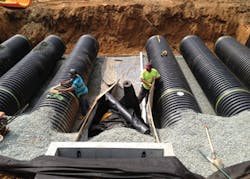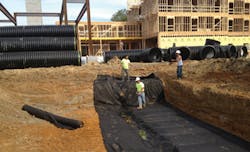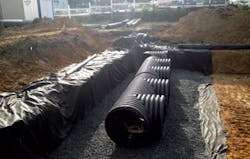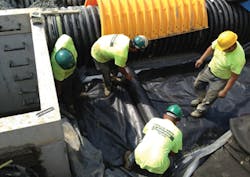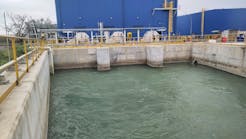Going Underground: Filtration Structure Key Component of Large Hotel Stormwater Management System
Adding a large-volume filtration structure to each of the two underground retention/detention systems for a new hotel in the city of Wilmington, Del., enhanced the ability of controlling pollutants from stormwater runoff.
While the stormwater management systems are large, space was at a premium, so they were installed under the parking lot, which maximized the use of the property. Land in this area is expensive and the systems were sized to meet stormwater flow runoff rates, but comparable-sized pollution control units that were part of each system would have been too large to fit the allotted space.
The system needed to provide for the Delaware water code and be able to remove any suspended solids because of the pollutants attached to those solids. There are, however, only a few systems that are approved in the state that can meet the clean water specifications.
The systems were designed to withstand freeze/thaw cycles plus the weight of vehicles parked overhead. Buried under the parking lot of the new 140-room hotel near creeks and tributaries leading to the Delaware River, the filtration structure is a key component of these waterways.
Each retention/detention system is more than 200 feet long by 40 feet wide and used a total of 2,530 linear feet of 42-inch diameter, high-density polyethylene (HDPE) corrugated pipe. The filtration structure is made up of 30 domed chambers wrapped in geotextile fabric. The systems are buried 12 inches deep for non-traffic areas, 18 inches for traffic areas and up to a maximum of 96 inches in other areas.
Originally, corrugated metal pipe (CMP) was specified for the job but was converted to the HDPE pipe due to its watertight seals, 100-year rated service life and the fact that one company could provide all materials and components.
"The owner was very concerned about the migration of soil and fines getting in through joints and leeching into the water table and being carried downstream," said Mike Holt, a regional representative of Advanced Drainage Systems Inc. (ADS).
To provide the watertight requirement, the N-12® pipe, manufactured by ADS, has a gasketed bell and spigot. In some pipe systems, freeze/thaw cycles will destroy the joints or the grout used as a seal. Silt and sediment will then infiltrate the system and be carried to streams, which, according to Holt, is a very bad condition and can be in conflict with Clean Water Act (CWA) regulations.
Incorporated into the runs of the HDPE pipe is a filtration unit known as a StormTech® Isolator™ Row (IR), which was constructed using StormTech SC-740™ Chambers with weirs at each end of each system. The IR is typically designed to capture the "first flush" and offers the versatility to be sized on a volume basis or flow rate basis. StormTech is a division of ADS.
"In conditions such as these where the area is tight," Swift stated, "the Infiltrator is about as good as it gets in providing that level of water quality in the smallest amount of area."
The first system, located on the south side of the property, is 208 x 43 feet and used six rows of 198 linear feet of N-12 pipe with the IR incorporating 18 SC-740 StormTech Chambers making up the last horizontal row. The second system on the north end of the property is 217 x 43 feet, also with six rows of HDPE pipe and 12 SC-740 StormTech chambers for the IR in the center.
The IR is a series of StormTech chambers surrounded with filter fabric and connected to a closely located manhole for easy access. The fabric-wrapped chambers provide for settling and filtration of sediment as stormwater rises in the IR and ultimately passes through the filter fabric. The open-bottom chambers and perforated sidewalls allow stormwater to flow both vertically and horizontally out of the chambers. Sediments are captured in the IR, protecting the storage areas of the adjacent stone and chambers from sediment accumulation.
Further, two different fabrics are used for the IR. A woven geotextile fabric is placed between the stone and IR chambers, which filters stormwater and provides a durable surface for maintenance. It also prevents scour of the underlying stone and remains intact during high-pressure jetting. A non-woven fabric is placed over the chambers to provide a filter media for flows passing through the perforations in the sidewall of the chamber.
The IR incorporates an upstream, standard manhole. This manhole not only provides access to the IR but typically includes a high-flow weir, such that stormwater flow rates or volumes that exceed the capacity of the IR overtop the overflow weir and discharge through a manifold to the other chambers.
Strategically located inspection ports allow for easy access to the system from the surface, eliminating the need to perform a confined space entry for inspection purposes. Maintenance is accomplished with the JetVac process, which uses a high-pressure water nozzle to propel itself down the IR while scouring and suspending sediments.
"An important component of any stormwater pollution prevention plan is inspection and maintenance," stated Holt. "The StormTech Isolator Row is a patented technique to inexpensively enhance total suspended solids (TSS) removal and provide easy access for inspection and maintenance."
For this project, the IR is between two catch basins, according to Holt. "To actually get everything into the Isolator Row, there are weirs in those catch basins with grates on the Isolator Row side of the weir, so anything that comes into the grates on top comes down on the Isolator Row and not just into the HDPE pipe," he said. "Most of the time you get small rain events, and everything will go into the Isolator Row and not even top over the weir."
Providing large storage volume per square foot of land area, StormTech chambers are designed in accordance with AASHTO and ASTM design standards, qualifying them for use in commercial and municipal projects. Manufactured using polyethylene, the chambers are rated by ADS for a 75-year service life.
"The practicality of a subsurface unit is being embraced more and more by engineers, urban planners and architects," observed Ron Vitarelli, vice president of Storm and Sanitary Sewer Market Development for ADS. "It saves valuable space, improves land use, provides a means to meet EPA regulations, and is a long-life, easy-to-install solution. The chambers and Isolator Row plus the HDPE pipe provide a highly cost-effective method for controlling stormwater."
"By putting the systems under the parking lot, you gain parking space, which is at a premium for any building, especially a hotel," he said. The alternative is to have a pond, he explained, which is neither a wise use of land nor good environmental stewardship. "There is also the liability associated with it," he said. "This new hotel is in an area where land is very expensive, so there's definitely the advantage of being able to supply them with some additional parking by putting retention/detention systems underneath the lot."
He noted that open ponds also draw geese and mosquitoes, which are a nuisance and can transmit pathogens such as West Nile virus. "An underground system with the proper filtration and storage system is a best management practice."
Archived IWW Issues
